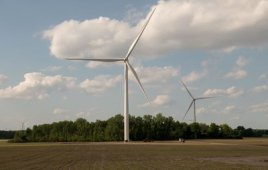David Clark
Wind Consultant
El Dorado Hills, Calif.
Here’s a little secret: You can probably use anyone’s condition monitoring on a single turbine and get data good enough to predict basic failures. But expand the monitoring scope to several turbines or multiple sites and everything changes.
To cost justify outfitting a 100-turbine farm with condition monitoring equipment, an O&M crew needs a heads-up on only two to three gearbox failures over the next 18 years. A design life of 20 years means 18 of those will be spent out of warranty. And no turbine runs better with age. Regardless of supplier, you will have to get vibration data from nacelles into a server, and then analyze all the data. These few key considerations can assist with the integration of condition monitoring into your wind farm and organization.

The vibration sensor will gather 2,100 measurements or more in a year. There are usually 6 to 8 sensors per turbine, each taking three vibration measurements (demodulation, velocity, and acceleration at a minimum). This potentially adds up to more than a potentially million readings annually which all must be transmitted out of the nacelle, stored, and analyzed
Sending data from the nacelle
First, know what is available in the turbine for transmitting data. Condition monitoring equipment will need a network connection to communicate with data storage on the ground. If it is not possible to run wire, then wireless is an option, with the right radio. More owners specify installing additiona runs of fiber at the time of commissioning. Other turbine models will have an Ethernet provision available in the nacelle or at the tower base. Connecting point A to point B seems basic. Nonetheless, consult with someone who knows from experience what works. There is a long list of what might work or should work. The list of what actually works is quite short.
Powering the system
Know what’s available and what’s required for your system. It will usually require a 100, 110, or 120 Vac, or 24 Vdc connection up-tower. Both are common. An existing power supply may also suffice. As with communications, power available in the varies greatly from site to site and manufacturer to manufacturer. A turbine a few years old will need assessments as to what’s available up-tower and whether or not it will work with your system. If you are specifying a new turbine’s requirements, foresight allows anticipating power requirements.
Managing the data
Depending on the number of turbines, wind-farm sites, and analysis location, determine a data-storage requirement for the condition-monitoring system. Consider these points to size the server:
- 8 measurement locations on a turbine x 3 vibration measurements each, plus one tachometer reading = 25 measurements per turbine.
- Each of the 25 measurements averages 2 kB in size or 50 kB of data per turbine each time readings are captured.
- 50 kB x 100 turbines x 2 daily recordings = 5,000 vibration measurements, or 10 MBs daily.
- This equates to 1,625,000 readings and 3.65 GB annually.
An actual site similar to the example size produced just over 10.5 GB in a year. This was after a year that included measurement interruptions due to lack of wind, service outages, and other events. This amount of data was accumulated with just two series of measurements a day. Increase this frequency to 12 times a day and you will quickly consume a terabyte of server space. If you have purchased a well-thought out system, it will have data thinning features to eliminate unneeded data over the course of time.

The table tells of the percentage of network bandwidth use for a typical condition monitoring system. Between SCADA and condition monitoring, does your network have enough capacity? You may have to work with what is installed.
Data frequency
Most people want to know why you cannot take more data more often. This perspective may stem from examining SCADA data which is so dynamic and ever changing, therefore, you need lots of it. Vibration condition monitoring must be the same, right? Wrong. Vibration is not ever changing. Either you have a bad bearing or you don’t. A failing main bearing it will take several months to fail. Taking readings every 6 sec on something that will take months to fail is quantity monitoring not quality monitoring. In addition, physical limitations choke the number of potential readings. There are two reasons for limitations:
One limitation to a high frequency of measurements is the time it takes to gather the readings. On a typical 18 rpm main bearing, readings taken in a common velocity vibration measurement might take up to three minutes for a single reading. There are 24 more measurements after the first three minutes so the average turbine will take upwards of 30 to 45 minutes for accurate and meaningful measurements, for each turbine on the site, and each time data is taken.
The second limitation comes from the available bandwidth. Some controllers take 90% and more of the available bandwidth, leaving only a small portion for condition monitoring. So even if you wanted to take more data, there is no way to transmit it.
Is there really a problem with fewer readings? Reading twice a day for a year equates to just over 18,000 vibration measurements per turbine, over 2,100 per point. If you can’t detect a bad generator bearing with 2,100 measurements, change analysts or condition monitoring systems. Reach David Clark at (530) 677-9785.
Analyzing the data
Suppose you take 1.65 million quality measurements annually for the 100-turbine example. Who will make sense of the measurements? It’s not as daunting a task as it sounds, but it could be worse if the measurements are not qualified. So who will monitor the fleet? What seems to work is a blend of temporary outsourced expertise and internal resources. This is highly dependent upon the number of turbines and internal capabilities. Usually the wind farm is set-up with the software and monitored for several months until the wind-farm owner gets someone trained as a vibration analyst at using the software and performing analysis. Most software platforms have features to streamline the analysis so it focuses only on areas that need attention.
This grossly over simplifies what is required for expertise. But suffice it to say, you will have to dedicate personnel on the task while partnering with a reputable vendor that has wind-specific vibration experience. Most farms and fleets are internally managed, assuming you can guarantee stability in the position and dedicate the time required today and a year from now.
WPE
Filed Under: Uncategorized





